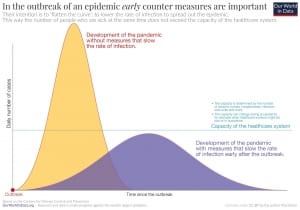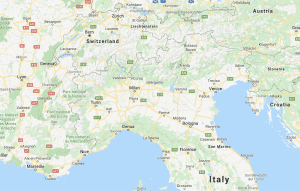Jason Van Schoor quotes a well respected friend who says, “I feel the pressure to give you a quick personal update about what is happening in Italy”
*
Updates
April 7, 2020 Journalist’s Resource article
An April 7, 2020 Journalist’s Resource article is entitled: “Social distancing time frames: How our expectations affect compliance.”
An excerpt reads:
In a new National Bureau of Economic Research working paper, researchers surveyed nearly 900 Italian residents to explore what happens when expectations are shattered about how long social distancing measures, like self-isolation, would last. Participants were less willing to do more self-isolating when told that social distancing time frames would run much longer or shorter than they anticipated.
“In a context where individual compliance has collective benefits, but full enforcement is costly and controversial, communication and persuasion have a fundamental role,” the authors write.
The working paper to which the article refers includes a note that reads:
NBER working papers are circulated for discussion and comment purposes. They have not been peer-reviewed or been subject to the review by the NBER Board of Directors that accompanies official NBER publications.
An April 8, 2020 New York Magazine article is entitled: “Losing Hope in the ICU ‘I don’t know how long I can keep doing this for.'”
An April 5, 2020 New York Times interactive article, which is highly informative, is entitled: “Italy’s virus shutdown came too late. What happens now?”
An excerpt reads:
Some scientists say that Italian officials did not act decisively to stop the virus early on, underestimating its danger and how quickly it spreads. “We realized the virus was here too late,” said Roberto Burioni, one of Italy’s leading virologists. “It was already spreading.”
Any decision to let up now and ease restrictions on movement, public health officials warned, would risk a new wave of infections. “We haven’t reached the peak, and we haven’t passed it,” Silvio Brusaferro, the head of Italy’s national health institute, said at a recent news conference.
A March 12, 2020 New York Times article is entitled: “How the World’s Largest Coronavirus Outbreaks Are Growing.”
An excerpt reads:
“Today, the red zone is Italy,” Matteo Renzi, a former prime minister, told The New York Times. But in 10 days, he warned, it will be Madrid, Paris and Berlin. If Italy cannot show how to stop the virus, he said, “the red zone will be Europe.”

The image courtesy of OurWorldInData.org is from a March 11, 2020 tweet from Greta Thunberg, who notes: “We can’t solve a crisis without treating it as a crisis and we must unite behind experts and science. This of course goes for all crises. Now the experts urge us to avoid big public gatherings for a better chance to #flattenthecurve and slow the spreading of the Coronavirus. 1/4”
Useful resource (New England Complex Systems Institute):
Stopping the Coronavirus Epidemic
Additional valuable resource (EndCoronavirus.org):
Early Outbreak Response Guidelines
The above-noted site includes a PDF entitled:
COVID-19 Recommendations for Policy Makers
A March 20, 2020 Reuters article is entitled: “Italy’s coronavirus deaths surge by 627 in a day, elderly at high risk.”
An excerpt reads:
In its most complete analysis of the outbreak yet published, the national health institute (ISS) said the average age of those who died was 78.5 years, with the youngest victim aged 31 and the oldest 103. The median age was 80.
[End of updates]
*
I recently came across – via Toomas Hendrik Ilves and Aki Heikkinen – a Twitter thread from Jason Van Schoor which ties in with recent posts entitled:
This American Life Episode 695: Everyone’s a Critic – Act Two – “Mr. Chen Goes to Wuhan”
Lombardy

Lombardy is a region in Northern Italy. Its capital is Milan. Source: Google Maps. Click on image to enlarge it.
A Lombardy Travel Guide at Google.com notes:
Lombardy is a region in Northern Italy. Its capital, Milan, is a global hub of fashion and finance, with many high-end shops and restaurants. Its Gothic Duomo di Milano cathedral and Santa Maria delle Grazie convent, housing Leonardo da Vinci’s painting of “The Last Supper,” testify to centuries of art and culture. North of Milan, Lake Como is an upscale alpine resort with dramatic scenery.
In the following text, ED refers to Emergency Department; ICU refers to Intensive Care Unit. Although not certain, I believe NIV in this case means Non Invasive Ventilation, and ITU means Intensive Therapy Unit (which, as I understand, deals with impending or actual organ failure). CPAP refers to Continuous Positive Airway Pressure. A&E in this case is likely Accident and Emergency, and resp means respiratory.
Jason Van Schoor writes:
From a well respected friend and intensivist/A&E consultant who is currently in northern Italy:
I feel the pressure to give you a quick personal update about what is happening in Italy, and also give some quick direct advice about what you should do.
First, Lombardy is the most developed region in Italy and it has a extraordinary good healthcare, I have worked in Italy, UK and Aus and don’t make the mistake to think that what is happening is happening in a 3rd world country.
The current situation is difficult to imagine and numbers do not explain things at all. Our hospitals are overwhelmed by Covid-19, they are running 200% capacity
We’ve stopped all routine, all ORs have been converted to ITUs and they are now diverting or not treating all other emergencies like trauma or strokes. There are hundreds of pts with severe resp failure and many of them do not have access to anything above a reservoir mask.
Patients above 65 or younger with comorbidities are not even assessed by ITU, I am not saying not tubed, I’m saying not assessed and no ITU staff attends when they arrest. Staff are working as much as they can but they are starting to get sick and are emotionally overwhelmed.
My friends call me in tears because they see people dying in front of them and they can only offer some oxygen. Ortho and pathologists are being given a leaflet and sent to see patients on NIV. PLEASE STOP, READ THIS AGAIN AND THINK.
We have seen the same pattern in different areas a week apart, and there is no reason that in a few weeks it won’t be the same everywhere, this is the pattern:
1) A few positive cases, first mild measures, people are told to avoid ED but still hang out in groups, everyone says not to panic.
2) Some moderate resp failures and a few severe ones that need tube, but regular access to ED is significantly reduced so everything looks great.
3) Tons of patients with moderate resp failure, that over time deteriorate to saturate ICUs first, then NIVs, then CPAP hoods, then even O2.
4) Staff gets sick so it gets difficult to cover for shifts, mortality spikes also from all other causes that can’t be treated properly.
Everything about how to treat them is online but the only things that will make a difference are: do not be afraid of massively strict measures to keep people safe.
If governments won’t do this at least keep your family safe, your loved ones with history of cancer or diabetes or any transplant will not be tubed if they need it even if they are young. By safe I mean YOU do not attend them and YOU decide who does and YOU teach them how to.
Another typical attitude is read and listen to people saying things like this and think “that’s bad dude” and then go out for dinner because you think you’ll be safe.
We have seen it, you won’t be if you don’t take it seriously. I really hope it won’t be as bad as here but prepare.
Jason Van Schoor @jasonvanschoor
@doctimcook
@GSTTanaesthesia
@RCoANews
@elboghdadly
@AAGBI_GAT
[End of thread]
Two transcripts of messages from Lombardy
In an additional tweet, Toomas Hendrik Ilves adds:
Listen or rather read the subtitles to this conference of doctors in Italy, apparently between Lombardy and Rome. It repeats what others have repeated here but with far greater detail. The denial propagated in the US right now is literally criminal:
Transcript of two WhatsApp audio files from Lombardy, epicenter of the Covid-19 outbreak
Simple math
Social distancing and the recommended basic hygiene (frequent hand washing; and keeping hands away from face) are among the practical recommendations, in the circumstances.
A March 10, 2020 Stat News opinion article, entitled “What does the coronavirus mean for the U.S. health care system? Some simple math offers alarming answers,” shares an overview of the math that’s involved.
An excerpt reads:
Unwarranted panic does no one any good, but neither does ill-informed complacency. It’s inappropriate to assuage the public with misleading comparisons to the seasonal flu or by assuring people that there’s “only” a 2% fatality rate. The fraction of cases that are severe really sets Covid-19 apart from more familiar respiratory illnesses, compounded by the fact that it’s whipping through a population without natural immune protection at lightning speed.

Leave a Reply
Want to join the discussion?Feel free to contribute!